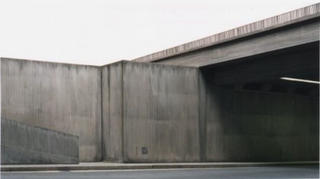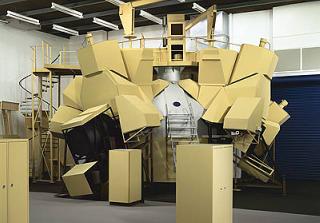Simulating, replacing, or otherwise

Oliver Boberg’s work identifies generic typologies of space – a loading dock, an underpass, or public square – and collects snapshots of different examples, in order to distil their essence into home-made hand painted table top models. He then hires a photographer to shoot this “ideal” reconstruction, creating an image of familiar yet placeless space that “verifies the imaginary.” According to Boberg, “It's as if I'm building a personal version of the world. I hope that in 20 years or so there will be something like a Boberg Universe."

Meanwhile Thomas Demand, a fellow German, takes photographs of life-size architectural models. Usually, he finds an image of a culturally or historically important space, and then rebuilds it in paper and cardboard. He then – you guessed it! – photographically reproduces the life-size simulation of a model that was built from a magazine or newspaper illustration in the first place. Not only that, but he apparently accounts for the distortions of single lens photography (as opposed to bifocal human vision) when building his model, "so that the experience of viewing the photograph of his construction is more true than viewing the photograph of the real thing." Although Demand’s photographs are titled generically (“Barn,” “Room,” “Studio,”) and although the fact that everything is made of colored paper takes away any specificity of place, these reconstructions are not Bobergian “types.” In fact, Demand’s Universe consists rather specifically of Hitler’s Berlin bunker, serial killer Jeffrey Dahmer’s hallway, the Berlin headquarters of the Stasi following the fall of the communist regime, and the untidy kitchen of Saddam Hussein’s Tikrit bunker.

The Demandian reproduce, reproduce, destroy, proliferate process (model/photograph/destroy model/multiple prints) has also encompassed the office where the rebuilding of Munich was planned after World War II, as well as a model/photograph that is either Bill Gates’ dorm room or the hotel room in which L. Ron Hubbard, founder of Scientology, wrote Dianetics (Google could go either way on that one). One of Demand's most recent works is "Space Simulator," which does not, as you might otherwise imagine, automate his working method. In fact, it seems rather nostalgic and Heath Robinson-esque – "like some kind of mistake – like a crumpled piece of paper, or a Frank Gehry building that hadn’t been finished.”

Is this the seductive engine of simulacra's final triumph?
And finally, there are more constructed histories in “Burned Cabin,” “Unpapered Cabin,” or “Dark Bathroom,” where very specific clues to solve real-life crimes lie hidden in "Nutshell Studies of Unexplained Death." Frances Glessner Lee (who grew up in Chicago’s Glessner House) built 19 dollhouses to teach forensics to police recruits. She noted, "The inspector may best examine them by imagining himself a trifle less than six inches tall." In case you were wondering, the photographer Corinne May Botz has already beaten you to it …






Comments are moderated.
If it's not spam, it will appear here shortly!
Post a Comment